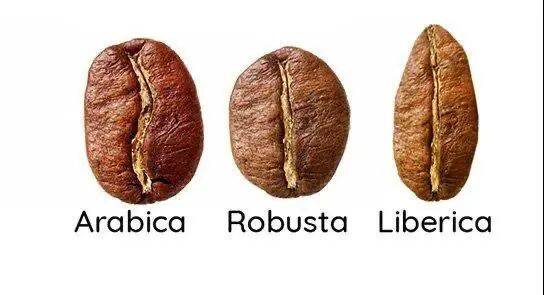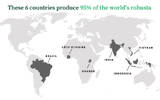Introduction of Robusta variety, Timor variety, Katim, Castillo variety and Yunnan small grain Katim
In today's coffee market, coffee can be divided into three categories: Arabica, Robusta and Liberica. At present, the most famous commercial coffee varieties are Arabica and Robusta.

Robusta (Robusta)
Robusta, which originated in the Congo in West Africa, is usually compared with Arabica, but they are two tree species in genetic sequence comparison. Robusta actually belongs to the Canefra species, also known as the Congolese species, but among the Canefola species, only the Robusta species can be commercialized and well known, so now Lobusta has replaced Canefra as a synonym for the species.
Coffee grows in the equator between the Tropic of Cancer and the Tropic of Cancer all over the world, and so does Robusta. But Robusta's growth conditions are not as harsh as Arabica. Robusta can plant and bear fruit at lower elevations, can adapt to high temperature environment, and has better disease resistance. Robusta grows faster and is more tolerant to extreme weather conditions. At present, Robusta is widely planted in Vietnam, Brazil, India and other countries.
Robusta contains between 2.7 and 4% caffeine, twice as much as Arabica. Caffeine is also a natural insect repellent for plants, which can be protected from some insects. Robusta is cross-pollinated, but Arabica is self-pollinated, and pollination involves genetic problems.
In general, cross-pollination produces higher plant varieties, and offspring produced by cross-pollination have the genetic symptoms of two parent plants, which may produce new characteristics that can help it produce in a changing environment. Arabica, which is self-pollinated, is more vulnerable because the genes become more and more single in the process of continuous reproduction, so when some viruses appear (such as leaf rust, berry disease, etc.), coffee with a single gene may be eliminated. So Robusta's strength lies in its ability to adapt to the environment by constantly changing its genes.

Robusta has higher levels of caffeine, amino acids and chlorogenic acid than Arabica, which is the source of bitterness. So Robusta said that the taste is thicker and lower, and the flavor is more inclined to walnuts, nuts, grains and so on. As a result, Robusta is not used as boutique coffee, but is mostly used in mixed beans or instant coffee.
However, with the development of the coffee industry, coffee varieties have been bred through continuous transplantation, mutation and mating, and Robusta can also be used to cross with Arabica so that it can have Robusta resistance genes. For example, Timor (known as Tim Tim in Indonesia), Katim Catimor, Castillo Castillo and so on.
In 1920, Timor Hybrid appeared on the island of East Timor, which is a natural cross between Arabica and Robusta. It belongs to Arabica coffee plant, but it has the disease resistance gene of Robusta. Therefore, the first generation of F1 hybrid group was produced by crossing Timor variety with Kaddura, which is now Katim Catimor. In 1961, the Columbia Research Center began to study varieties resistant to leaf rust, such as Kaddura and Timor Hybrid. After 23 years of research, six varieties such as Castillo were developed and widely planted in 2005.
Qianjie also has a small Katim coffee bean from Yunnan, washed and tasted with melons and fruits, with a little plum acid and cocoa flavor, black tea taste and overall balance.
Important Notice :
前街咖啡 FrontStreet Coffee has moved to new addredd:
FrontStreet Coffee Address: 315,Donghua East Road,GuangZhou
Tel:020 38364473
- Prev

Is the smart cup a filter cup? The way the smart cup is used, the way it is extracted, and the degree of grinding its coffee powder should use?
Recently, more and more filter cups are equipped with controllable valves with switch function, and many merchants will give them the name of "Smart Cup" for sale. Strictly speaking, their usefulness is very different from that of the Smart Cup, and in principle, only those sold by the Mr.Clever brand can be called
- Next

WCR is about to launch the Robusta breeding program, and trials have been conducted to plant Robusta varieties in Uganda.
Over the past few decades, Robusta has grown into a major market force for coffee, rising from 25% to 40% of global coffee production since the early 1990s. Judging from the current situation, the demand for Robusta will increase in the future. However, Robusta's planting also
Related
- Being chased out of the rain in front of Starbucks?! Store: Sheltering from rain under umbrellas poses a safety hazard
- The white moonlight has changed?! Lucky launches "Big Winter Pear American"
- Hand-brewed coffee three-stage method, high-sweet and universal brewing method to share! What does the high sweet water level of hand-brewed coffee mean?
- What is the difference between raw, refined and full espresso coffee? How to extract espresso and taste good?
- A complete list of coffee bean names and their meanings! What is Yejia Shefi coffee? Where is Mantelin coffee?
- What grade does Arida Manor Kaduai coffee beans belong to? What treatment is Arida ASD slow anaerobic sun exposure?
- The milk tea cup becomes smaller?! Overlord Tea Girl launches a new "Return to Yunnan" series
- Accused of selling counterfeit and high-priced coffee beans! Well-known boutique coffee brand "Oukelao" bowed and apologized!
- How to make espresso dumplings? Can I eat coffee and glutinous rice balls together?
- Save the unformed and stagnant powder cakes in one second! What is the problem with stagnant water in the powder bowl of the espresso machine?

